Burmese vs Blackfeet Community Comparison
COMPARE
Burmese
Blackfeet
Social Comparison
Social Comparison
Burmese
Blackfeet
10,002
SOCIAL INDEX
97.5/ 100
SOCIAL RATING
4th/ 347
SOCIAL RANK
1,951
SOCIAL INDEX
17.1/ 100
SOCIAL RATING
279th/ 347
SOCIAL RANK
Blackfeet Integration in Burmese Communities
The statistical analysis conducted on geographies consisting of 281,091,582 people shows a mild negative correlation between the proportion of Blackfeet within Burmese communities in the United States with a correlation coefficient (R) of -0.367. On average, for every 1% (one percent) increase in Burmese within a typical geography, there is a decrease of 0.002% in Blackfeet. To illustrate, in a geography comprising of 100,000 individuals, a rise of 1,000 Burmese corresponds to a decrease of 2.4 Blackfeet.
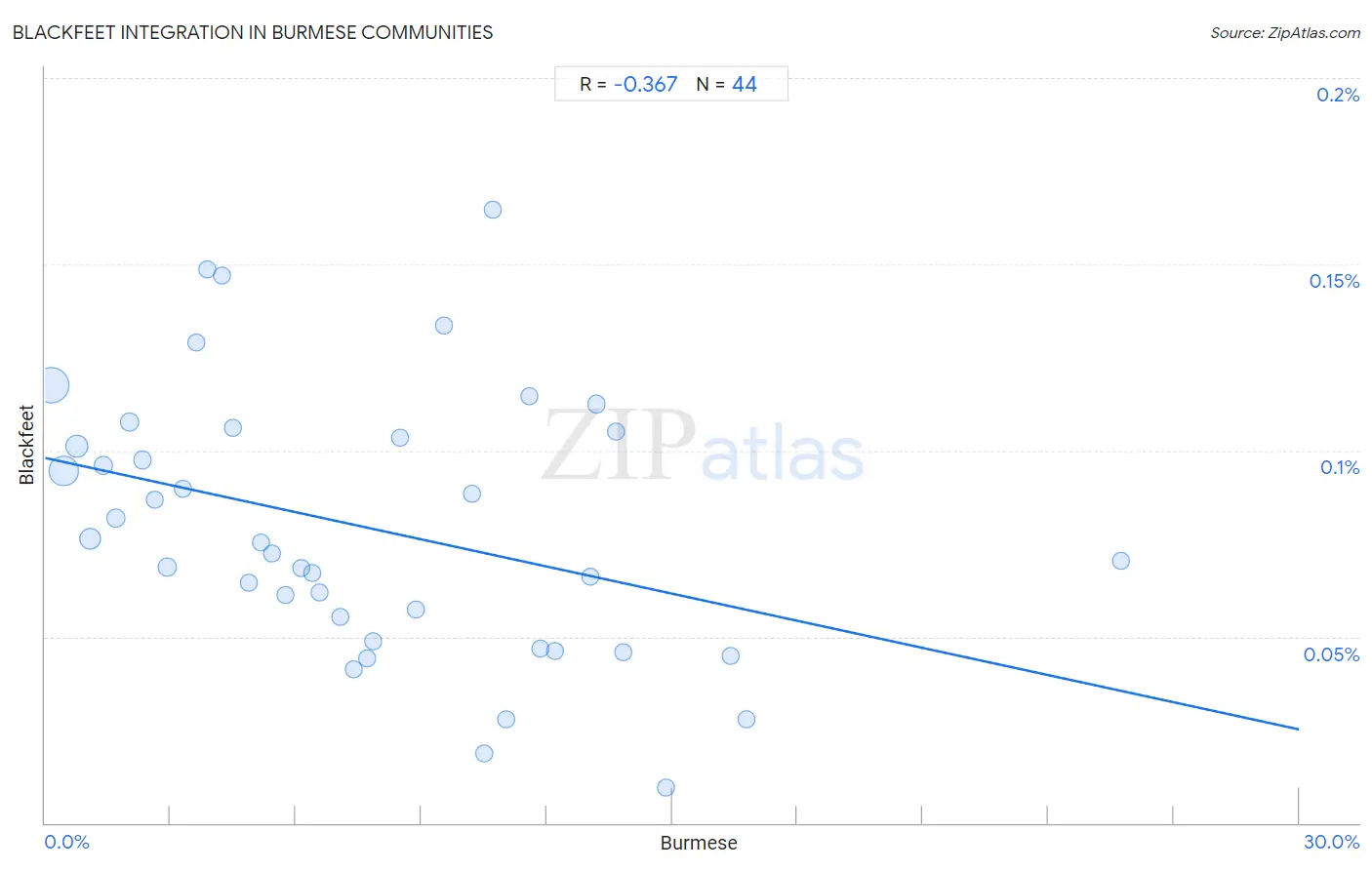
Burmese vs Blackfeet Income
When considering income, the most significant differences between Burmese and Blackfeet communities in the United States are seen in median household income ($103,145 compared to $73,509, a difference of 40.3%), householder income ages 45 - 64 years ($121,444 compared to $86,595, a difference of 40.2%), and householder income ages 25 - 44 years ($113,701 compared to $81,531, a difference of 39.5%). Conversely, both communities are more comparable in terms of wage/income gap (28.0% compared to 25.2%, a difference of 11.0%), householder income under 25 years ($54,800 compared to $48,603, a difference of 12.8%), and median female earnings ($44,911 compared to $35,864, a difference of 25.2%).

| Income Metric | Burmese | Blackfeet |
| Per Capita Income | Exceptional $52,005 | Tragic $37,695 |
| Median Family Income | Exceptional $123,369 | Tragic $88,717 |
| Median Household Income | Exceptional $103,145 | Tragic $73,509 |
| Median Earnings | Exceptional $54,559 | Tragic $41,822 |
| Median Male Earnings | Exceptional $65,236 | Tragic $48,402 |
| Median Female Earnings | Exceptional $44,911 | Tragic $35,864 |
| Householder Age | Under 25 years | Exceptional $54,800 | Tragic $48,603 |
| Householder Age | 25 - 44 years | Exceptional $113,701 | Tragic $81,531 |
| Householder Age | 45 - 64 years | Exceptional $121,444 | Tragic $86,595 |
| Householder Age | Over 65 years | Exceptional $71,139 | Tragic $54,029 |
| Wage/Income Gap | Tragic 28.0% | Good 25.2% |
Burmese vs Blackfeet Poverty
When considering poverty, the most significant differences between Burmese and Blackfeet communities in the United States are seen in receiving food stamps (8.6% compared to 14.3%, a difference of 65.1%), child poverty under the age of 5 (13.2% compared to 21.8%, a difference of 65.0%), and child poverty under the age of 16 (12.8% compared to 20.2%, a difference of 57.7%). Conversely, both communities are more comparable in terms of seniors poverty over the age of 75 (11.7% compared to 13.7%, a difference of 17.4%), single father poverty (15.5% compared to 18.5%, a difference of 19.7%), and female poverty among 18-24 year olds (18.9% compared to 23.6%, a difference of 24.9%).
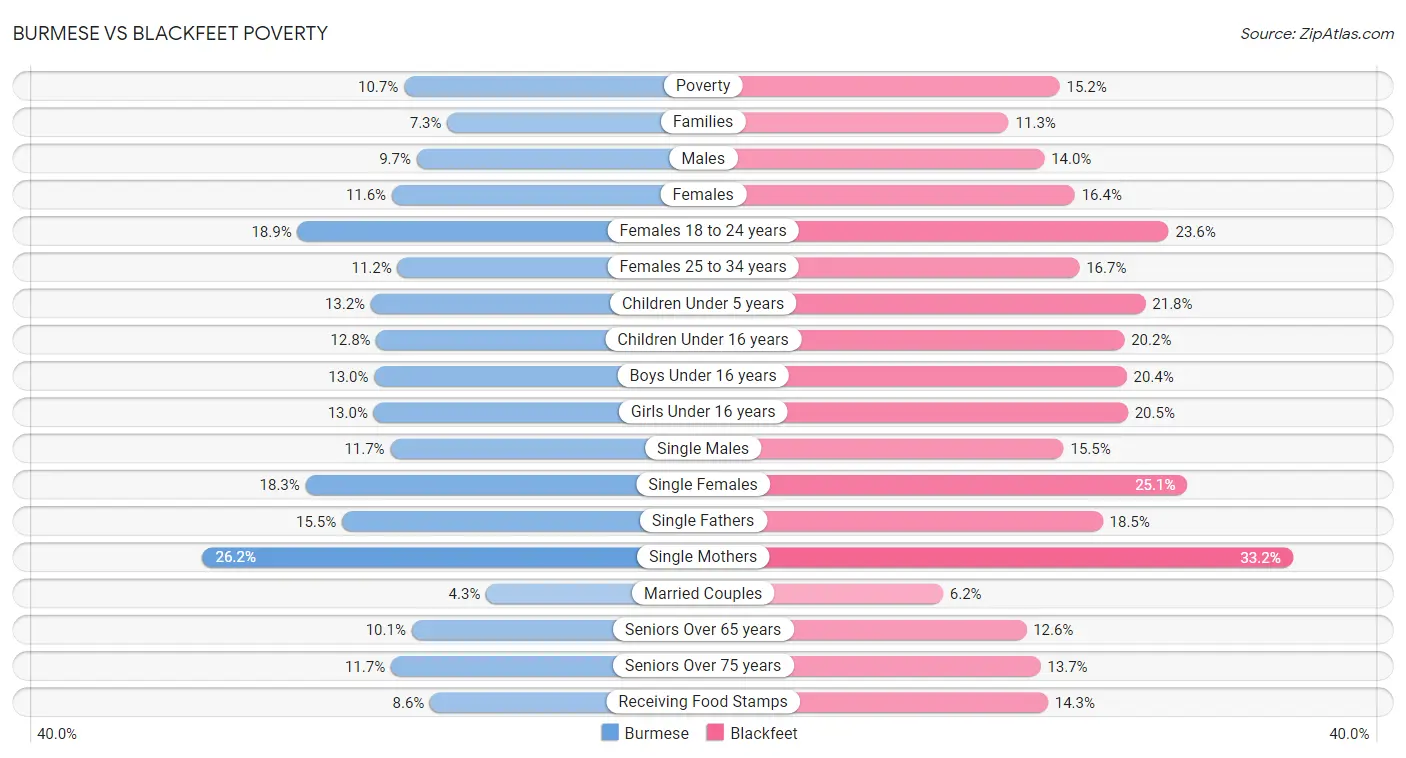
| Poverty Metric | Burmese | Blackfeet |
| Poverty | Exceptional 10.7% | Tragic 15.2% |
| Families | Exceptional 7.3% | Tragic 11.3% |
| Males | Exceptional 9.7% | Tragic 14.0% |
| Females | Exceptional 11.6% | Tragic 16.4% |
| Females 18 to 24 years | Exceptional 18.9% | Tragic 23.6% |
| Females 25 to 34 years | Exceptional 11.2% | Tragic 16.7% |
| Children Under 5 years | Exceptional 13.2% | Tragic 21.8% |
| Children Under 16 years | Exceptional 12.8% | Tragic 20.2% |
| Boys Under 16 years | Exceptional 13.0% | Tragic 20.4% |
| Girls Under 16 years | Exceptional 13.0% | Tragic 20.5% |
| Single Males | Exceptional 11.7% | Tragic 15.5% |
| Single Females | Exceptional 18.3% | Tragic 25.1% |
| Single Fathers | Exceptional 15.5% | Tragic 18.5% |
| Single Mothers | Exceptional 26.2% | Tragic 33.2% |
| Married Couples | Exceptional 4.3% | Tragic 6.2% |
| Seniors Over 65 years | Exceptional 10.1% | Tragic 12.6% |
| Seniors Over 75 years | Excellent 11.7% | Tragic 13.7% |
| Receiving Food Stamps | Exceptional 8.6% | Tragic 14.3% |
Burmese vs Blackfeet Unemployment
When considering unemployment, the most significant differences between Burmese and Blackfeet communities in the United States are seen in unemployment among women with children under 6 years (6.5% compared to 8.7%, a difference of 34.0%), unemployment among women with children under 18 years (4.9% compared to 6.4%, a difference of 28.6%), and unemployment among ages 25 to 29 years (6.2% compared to 7.9%, a difference of 27.1%). Conversely, both communities are more comparable in terms of unemployment among ages 60 to 64 years (4.8% compared to 4.9%, a difference of 2.9%), unemployment among ages 65 to 74 years (5.2% compared to 5.5%, a difference of 5.2%), and unemployment among seniors over 65 years (5.0% compared to 5.3%, a difference of 5.7%).
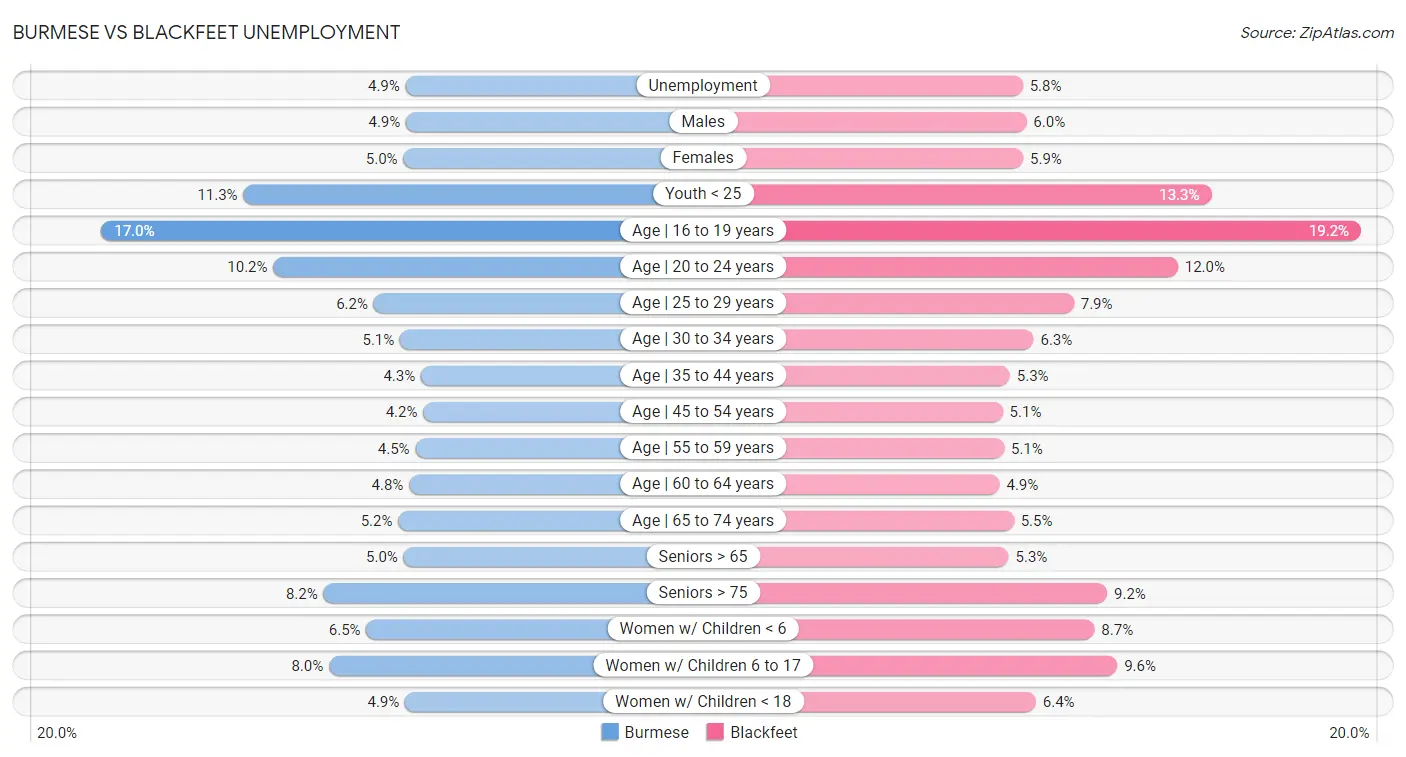
| Unemployment Metric | Burmese | Blackfeet |
| Unemployment | Exceptional 4.9% | Tragic 5.8% |
| Males | Exceptional 4.9% | Tragic 6.0% |
| Females | Exceptional 5.0% | Tragic 5.9% |
| Youth < 25 | Excellent 11.3% | Tragic 13.3% |
| Age | 16 to 19 years | Exceptional 17.0% | Tragic 19.2% |
| Age | 20 to 24 years | Excellent 10.2% | Tragic 12.0% |
| Age | 25 to 29 years | Exceptional 6.2% | Tragic 7.9% |
| Age | 30 to 34 years | Exceptional 5.1% | Tragic 6.3% |
| Age | 35 to 44 years | Exceptional 4.3% | Tragic 5.3% |
| Age | 45 to 54 years | Exceptional 4.2% | Tragic 5.1% |
| Age | 55 to 59 years | Exceptional 4.5% | Tragic 5.1% |
| Age | 60 to 64 years | Excellent 4.8% | Poor 4.9% |
| Age | 65 to 74 years | Exceptional 5.2% | Tragic 5.5% |
| Seniors > 65 | Exceptional 5.0% | Tragic 5.3% |
| Seniors > 75 | Exceptional 8.2% | Tragic 9.2% |
| Women w/ Children < 6 | Exceptional 6.5% | Tragic 8.7% |
| Women w/ Children 6 to 17 | Exceptional 8.0% | Tragic 9.6% |
| Women w/ Children < 18 | Exceptional 4.9% | Tragic 6.4% |
Burmese vs Blackfeet Labor Participation
When considering labor participation, the most significant differences between Burmese and Blackfeet communities in the United States are seen in in labor force | age 16-19 (34.5% compared to 38.9%, a difference of 12.9%), in labor force | age > 16 (66.2% compared to 63.2%, a difference of 4.7%), and in labor force | age 45-54 (83.6% compared to 80.0%, a difference of 4.5%). Conversely, both communities are more comparable in terms of in labor force | age 20-24 (73.6% compared to 75.5%, a difference of 2.6%), in labor force | age 30-34 (85.3% compared to 82.8%, a difference of 2.9%), and in labor force | age 25-29 (85.1% compared to 82.6%, a difference of 3.1%).

| Labor Participation Metric | Burmese | Blackfeet |
| In Labor Force | Age > 16 | Exceptional 66.2% | Tragic 63.2% |
| In Labor Force | Age 20-64 | Exceptional 80.3% | Tragic 77.0% |
| In Labor Force | Age 16-19 | Tragic 34.5% | Exceptional 38.9% |
| In Labor Force | Age 20-24 | Tragic 73.6% | Excellent 75.5% |
| In Labor Force | Age 25-29 | Exceptional 85.1% | Tragic 82.6% |
| In Labor Force | Age 30-34 | Exceptional 85.3% | Tragic 82.8% |
| In Labor Force | Age 35-44 | Exceptional 84.7% | Tragic 81.9% |
| In Labor Force | Age 45-54 | Exceptional 83.6% | Tragic 80.0% |
Burmese vs Blackfeet Family Structure
When considering family structure, the most significant differences between Burmese and Blackfeet communities in the United States are seen in births to unmarried women (26.4% compared to 37.9%, a difference of 43.8%), single mother households (5.3% compared to 7.5%, a difference of 41.5%), and single father households (2.0% compared to 2.7%, a difference of 32.9%). Conversely, both communities are more comparable in terms of average family size (3.22 compared to 3.24, a difference of 0.87%), family households (65.7% compared to 63.6%, a difference of 3.4%), and family households with children (28.5% compared to 27.5%, a difference of 3.7%).

| Family Structure Metric | Burmese | Blackfeet |
| Family Households | Exceptional 65.7% | Tragic 63.6% |
| Family Households with Children | Exceptional 28.5% | Average 27.5% |
| Married-couple Households | Exceptional 49.8% | Tragic 43.8% |
| Average Family Size | Fair 3.22 | Good 3.24 |
| Single Father Households | Exceptional 2.0% | Tragic 2.7% |
| Single Mother Households | Exceptional 5.3% | Tragic 7.5% |
| Currently Married | Exceptional 48.9% | Tragic 44.2% |
| Divorced or Separated | Exceptional 10.7% | Tragic 13.3% |
| Births to Unmarried Women | Exceptional 26.4% | Tragic 37.9% |
Burmese vs Blackfeet Vehicle Availability
When considering vehicle availability, the most significant differences between Burmese and Blackfeet communities in the United States are seen in 4 or more vehicles in household (6.8% compared to 7.0%, a difference of 2.7%), 2 or more vehicles in household (57.8% compared to 56.4%, a difference of 2.5%), and 3 or more vehicles in household (20.6% compared to 20.9%, a difference of 1.3%). Conversely, both communities are more comparable in terms of 1 or more vehicles in household (90.4% compared to 90.6%, a difference of 0.17%), no vehicles in household (9.7% compared to 9.6%, a difference of 1.1%), and 3 or more vehicles in household (20.6% compared to 20.9%, a difference of 1.3%).

| Vehicle Availability Metric | Burmese | Blackfeet |
| No Vehicles Available | Excellent 9.7% | Exceptional 9.6% |
| 1+ Vehicles Available | Excellent 90.4% | Exceptional 90.6% |
| 2+ Vehicles Available | Exceptional 57.8% | Excellent 56.4% |
| 3+ Vehicles Available | Exceptional 20.6% | Exceptional 20.9% |
| 4+ Vehicles Available | Exceptional 6.8% | Exceptional 7.0% |
Burmese vs Blackfeet Education Level
When considering education level, the most significant differences between Burmese and Blackfeet communities in the United States are seen in professional degree (6.1% compared to 3.5%, a difference of 76.8%), doctorate degree (2.6% compared to 1.5%, a difference of 75.2%), and master's degree (19.7% compared to 12.1%, a difference of 63.0%). Conversely, both communities are more comparable in terms of 6th grade (97.3% compared to 97.3%, a difference of 0.0%), 5th grade (97.5% compared to 97.5%, a difference of 0.010%), and 4th grade (97.7% compared to 97.7%, a difference of 0.020%).
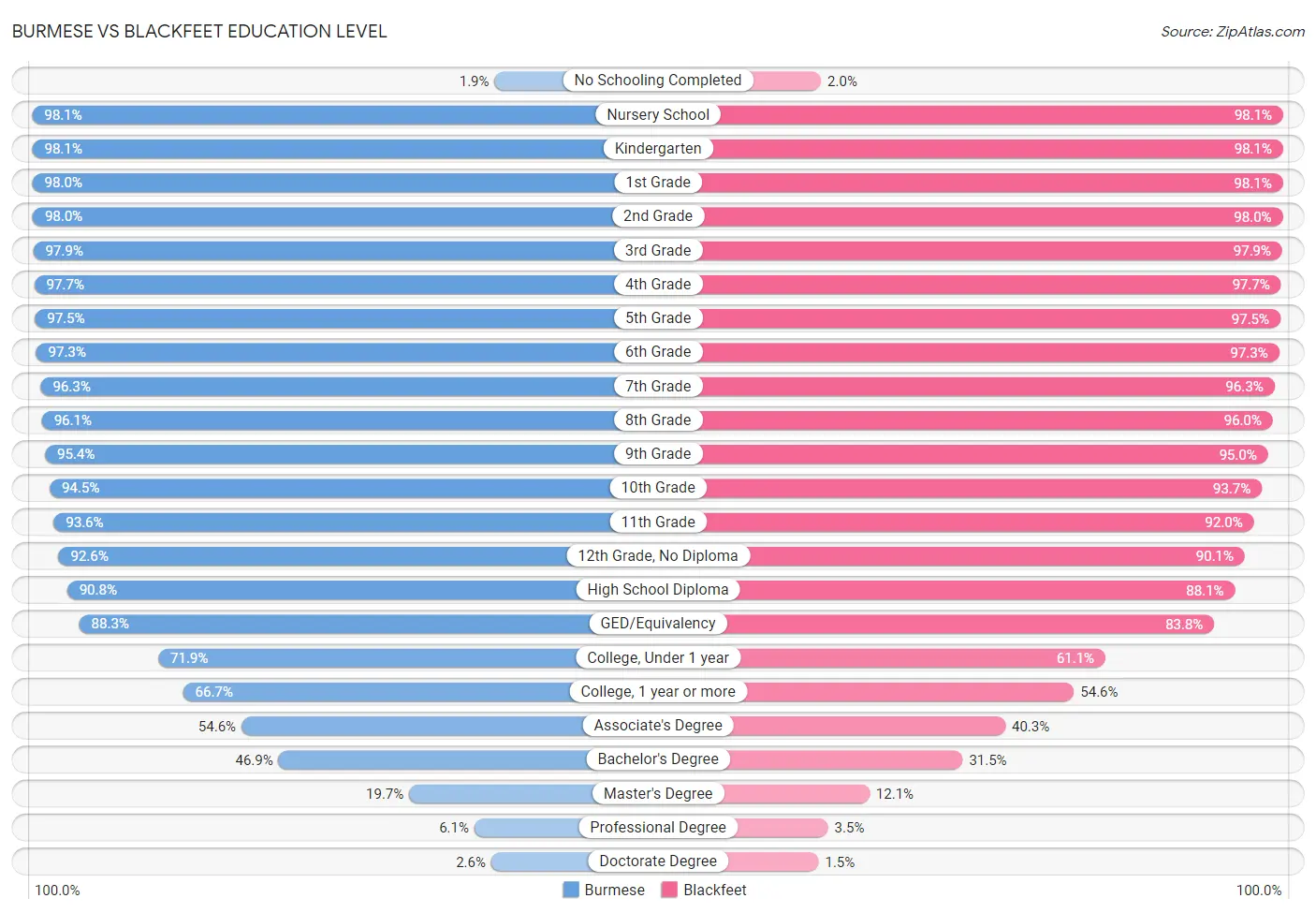
| Education Level Metric | Burmese | Blackfeet |
| No Schooling Completed | Excellent 1.9% | Good 2.0% |
| Nursery School | Excellent 98.1% | Excellent 98.1% |
| Kindergarten | Excellent 98.1% | Excellent 98.1% |
| 1st Grade | Excellent 98.0% | Excellent 98.1% |
| 2nd Grade | Excellent 98.0% | Excellent 98.0% |
| 3rd Grade | Good 97.9% | Excellent 97.9% |
| 4th Grade | Excellent 97.7% | Excellent 97.7% |
| 5th Grade | Excellent 97.5% | Excellent 97.5% |
| 6th Grade | Excellent 97.3% | Excellent 97.3% |
| 7th Grade | Excellent 96.3% | Excellent 96.3% |
| 8th Grade | Exceptional 96.1% | Excellent 96.0% |
| 9th Grade | Exceptional 95.4% | Good 95.0% |
| 10th Grade | Exceptional 94.5% | Average 93.7% |
| 11th Grade | Exceptional 93.6% | Poor 92.0% |
| 12th Grade, No Diploma | Exceptional 92.6% | Tragic 90.1% |
| High School Diploma | Exceptional 90.8% | Tragic 88.1% |
| GED/Equivalency | Exceptional 88.3% | Tragic 83.8% |
| College, Under 1 year | Exceptional 71.9% | Tragic 61.1% |
| College, 1 year or more | Exceptional 66.7% | Tragic 54.6% |
| Associate's Degree | Exceptional 54.6% | Tragic 40.3% |
| Bachelor's Degree | Exceptional 46.9% | Tragic 31.5% |
| Master's Degree | Exceptional 19.7% | Tragic 12.1% |
| Professional Degree | Exceptional 6.1% | Tragic 3.5% |
| Doctorate Degree | Exceptional 2.6% | Tragic 1.5% |
Burmese vs Blackfeet Disability
When considering disability, the most significant differences between Burmese and Blackfeet communities in the United States are seen in disability age 35 to 64 (9.2% compared to 14.1%, a difference of 52.6%), disability age under 5 (1.1% compared to 1.6%, a difference of 46.6%), and vision disability (1.8% compared to 2.6%, a difference of 41.9%). Conversely, both communities are more comparable in terms of disability age over 75 (45.9% compared to 48.8%, a difference of 6.2%), cognitive disability (16.7% compared to 18.3%, a difference of 9.6%), and self-care disability (2.3% compared to 2.7%, a difference of 21.4%).
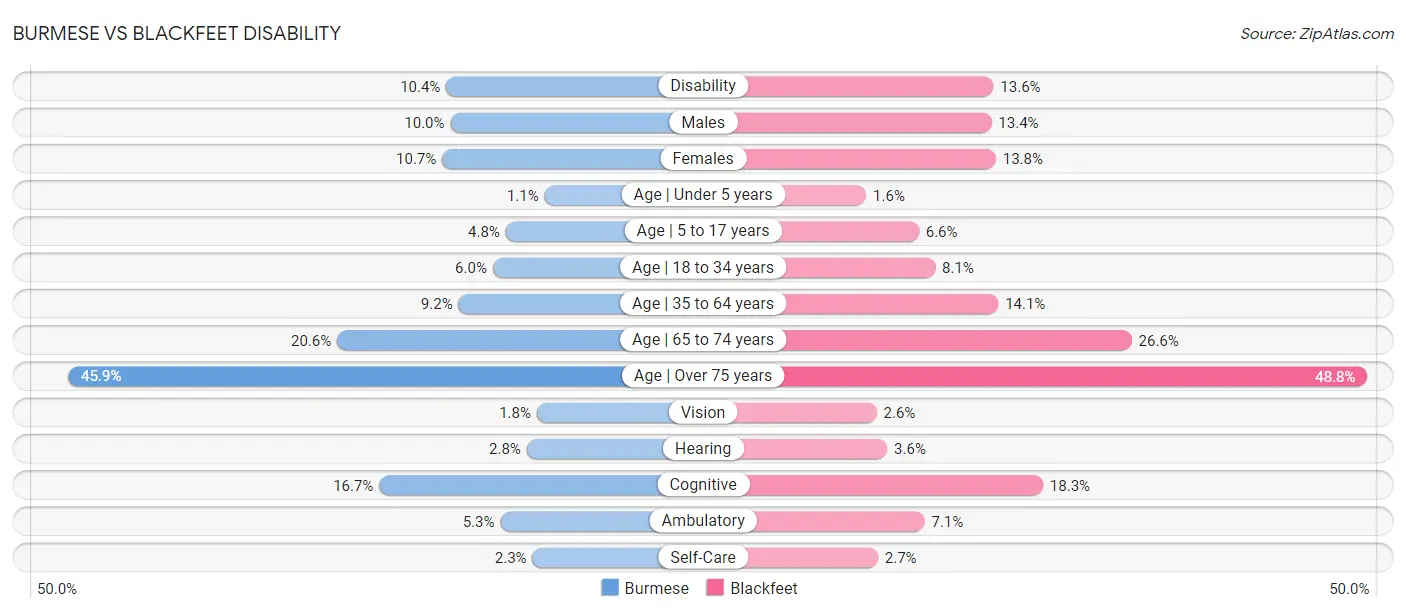
| Disability Metric | Burmese | Blackfeet |
| Disability | Exceptional 10.4% | Tragic 13.6% |
| Males | Exceptional 10.0% | Tragic 13.4% |
| Females | Exceptional 10.7% | Tragic 13.8% |
| Age | Under 5 years | Exceptional 1.1% | Tragic 1.6% |
| Age | 5 to 17 years | Exceptional 4.8% | Tragic 6.6% |
| Age | 18 to 34 years | Exceptional 6.0% | Tragic 8.1% |
| Age | 35 to 64 years | Exceptional 9.2% | Tragic 14.1% |
| Age | 65 to 74 years | Exceptional 20.6% | Tragic 26.6% |
| Age | Over 75 years | Exceptional 45.9% | Tragic 48.8% |
| Vision | Exceptional 1.8% | Tragic 2.6% |
| Hearing | Exceptional 2.8% | Tragic 3.6% |
| Cognitive | Exceptional 16.7% | Tragic 18.3% |
| Ambulatory | Exceptional 5.3% | Tragic 7.1% |
| Self-Care | Exceptional 2.3% | Tragic 2.7% |